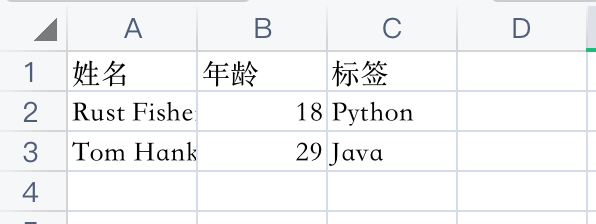Python3 读写csv文件中的数字
本文最后更新于:2023年4月15日 下午
环境与工具
- Python3
- PyCharm CE
csv简介
什么是csv?csv是逗号分隔的一种文件格式。
例如下面这个csv格式的文本。1
2
3姓名,年龄,标签
Rust Fisher,18,Python
Tom Hanks,29,Java
这样的.csv文件可以用Excel或者WPS打开,会给出表格的形式。

要注意的是,csv是文本格式,并不是Excel的格式。我们用文本编辑器(例如xcode,记事本)是可以直接编辑它的。
读写csv文件
读文件时先产生str的列表,把最后的换行符删掉;然后一个个str转换成int1
2
3
4
5
6
7
8
9
10
11
12
13
14
15
16
17
18## 读写csv文件
csv_file = 'datas.csv'
csv = open(csv_file,'w')
for i in range(1,20):
csv.write(str(i) + ',')
if i % 10 == 0:
csv.write('\n')
csv.close()
result = []
with open(csv_file,'r') as f:
for line in f:
linelist = line.split(',')
linelist.pop()# delete: \n
for index, item in enumerate(linelist):
result.append(int(item))
print('\nResult is \n' , result)
输出:1
2Result is
[1, 2, 3, 4, 5, 6, 7, 8, 9, 10, 11, 12, 13, 14, 15, 16, 17, 18, 19]
检查目录是否存在
若目标目录不存在,则新建一个目录1
2
3
4
5
6import os
json_dir = "../dir_json/2017-04/"
if not os.path.exists(json_dir):
print("json dir not found")
os.makedirs(json_dir)
print("Create dir " + json_dir)
写文件时指定格式
参考下面的代码,打开文件时指定utf8,转换成json时指定ensure_ascii=False1
2
3import json
json_file = open(json_dir + id + '.json', 'w', encoding='utf8')
json_file.write(json.dumps(data_dict, ensure_ascii=False))
避免写成的json文件乱码
函数 enumerate(iterable, start=0)
返回一个enumerate对象。iterable必须是一个句子,迭代器或者支持迭代的对象。
enumerate示例1:1
2
3
4
5
6
7
8>>> data = [1,2,3]
>>> for i, item in enumerate(data):
print(i,item)
0 1
1 2
2 3
示例2:1
2
3
4
5
6
7
8>>> line = 'one'
>>> for i, item in enumerate(line,4):
print(i,item)
4 o
5 n
6 e
参考: https://docs.python.org/3/library/functions.html?highlight=enumerate#enumerate
class int(x=0)
class int(x, base=10)
返回一个Integer对象。对于浮点数,会截取成整数。1
2
3
4
5
6
7
8
9
10
11>>> print(int('-100'),int('0'),int('3'))
-100 0 3
>>> int(7788)
7788
>>> int(7.98)
7
>>> int('2.33')
Traceback (most recent call last):
File "<pyshell#27>", line 1, in <module>
int('2.33')
ValueError: invalid literal for int() with base 10: '2.33'
读取binary文件
逐个byte读取,注意用b''来判断是否读到文件尾部1
2
3
4
5
6
7
8
9
10
11@staticmethod
def convert_bin_to_csv(bin_file_path, csv_file_path):
if not os.path.exists(bin_file_path):
print("Binary file is not exist! " + bin_file_path)
return
with open(bin_file_path, "rb") as bin_f:
cur_byte = bin_f.read(1)
while cur_byte != b'':
# Do stuff with byte.
print(int.from_bytes(cur_byte, byteorder='big', signed=True))
cur_byte = bin_f.read(1)
读取到的byte可以转换为int,参考文档
这里 cur_byte 类似于 b'\x08'1
print(int.from_bytes(cur_byte, byteorder='big', signed=True))
从bin中读取数据并存入CSV文件中
先从bin中读取byte,规定好几个字节凑成1个数字。
按每行一个数字的格式写入CSV文件。
1 | |
bin存储的数据格式一定要商量好。